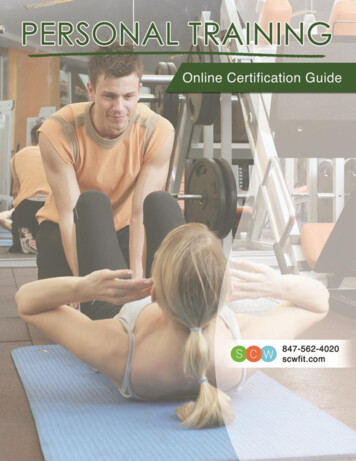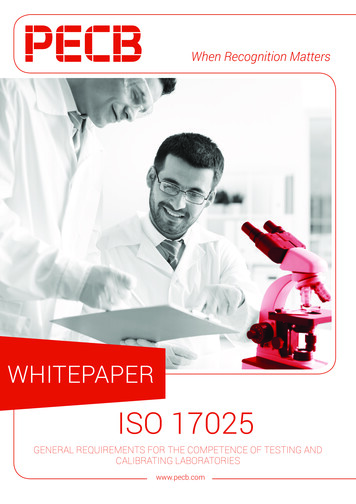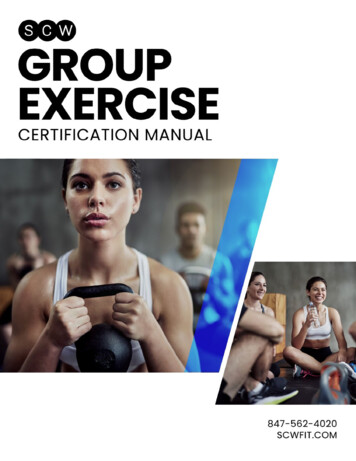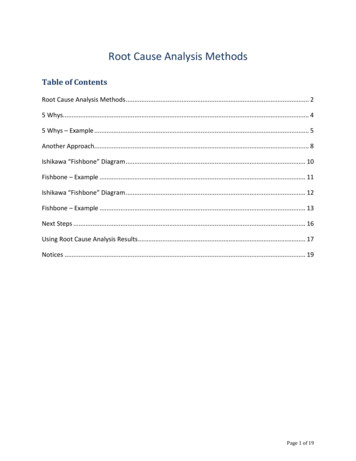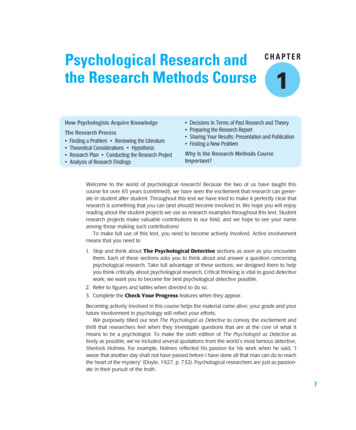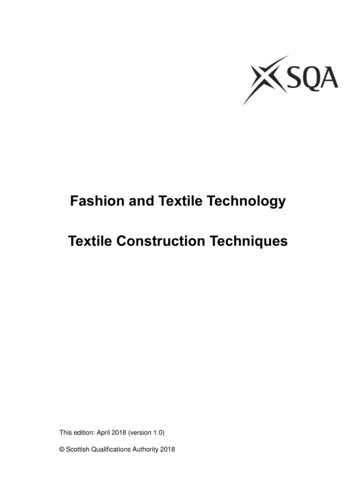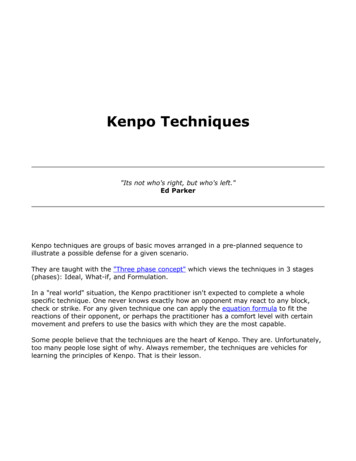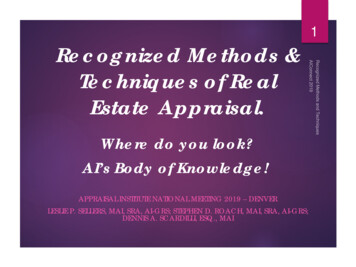
Transcription
Recognized Methods &Techniques of RealEstate Appraisal.Where do you look?AI’s Body of Knowledge!APPRAISAL INSTITUTE NATIONAL MEETING 2019 – DENVERLESLIE P. SELLERS, MAI, SRA, AI-GRS; STEPHEN D. ROACH, MAI, SRA, AI-GRS;DENNIS A. SCARDILLI, ESQ., MAI1
2PresentersLeslie P. Sellers, MAI, SRA, AI-GRSChair of the Appraisal Institute Body of KnowledgeCommittee and former AI PresidentStephen D. Roach, MAI, SRA, AI-GRSChair of the Appraisal Institute Education CommitteeDennis A. Scardilli, Esq., MAIAppraiser Defense AttorneyRecognized Methods and TechniquesAIConnect 2019
Our presentation3Our presentation will:1. Identify BOK elements;2. Discuss how/why the AI BOK is the basis of RMATsof real estate appraisal in the US;3. Review appraisal standards, including USPAP andAI’s SVP, then relate them to the BOK; and4. Discuss how the BOK, RMATs, and appraisalstandards can be used in everyday appraisalpractice.Recognized Methods and TechniquesAIConnect 2019
Our presentation4Goals of this presentation are to provide attendees with:1. Awareness of the AI BOK, and how it can beused as the basis of appraisal RMATs;2. Ability to relate the BOK to RMATs, and toUSPAP (or other standards), everyday practice;and3. Knowledge of how to use BOK/RMATs to avoidand defend allegations of USPAP nonconformities.Recognized Methods and TechniquesAIConnect 2019
5Introduction Let’ssay that you get an assignment todo an appraisal and you want to goback to basics to make sure you’refollowing professional standards . . . So,you open USPAP and start reading. What’sthe first “Standard Rule” youcome across?Recognized Methods and TechniquesAIConnect 2019
6Introduction Surely the standards define what constitutes“recognized methods and techniques”, right? Nope – the term is not defined in USPAP.Recognized Methods and TechniquesAIConnect 2019
Introduction 7Further, the comment to this Standard Rule says:The word “change” is in here 7 timesRecognized Methods and TechniquesAIConnect 2019
8Introduction Situationreport from the field: Weare required to be aware of,understand, and correctly employrecognized methods and techniques(“RMATs”) Theterm isn’t defined in USPAP (or SVP) RMATsare NOT static; they’re dynamicRecognized Methods and TechniquesAIConnect 2019
9Introduction Arethe presenters critical of USPAPand SVP for not defining whatconstitutes RMATs? NOPE – that’s not the purpose of aset of professional standards! The presenters believe thatstandards should be principlesbased.Recognized Methods and TechniquesAIConnect 2019
Introduction10 Whereyou gonna’ lookfor RMATs? We suggest the AppraisalInstitute’s Body ofknowledge (“BOK”)Recognized Methods and TechniquesAIConnect 2019
Introduction11We suggest that this information ishelpful for use not only during thisPresentation, but when you leavehere and for the rest of yourprofessional career as anappraiser.Recognized Methods and TechniquesAIConnect 2019
12Understanding of USPAPDennis Scardilli, Esq., MAI
Next issue13Do you thoroughly, completely, andunequivocally understand every aspectof USPAP?If not, please raise your hand and leaveit up.Recognized Methods and TechniquesAIConnect 2019
Next issue14Have you ever read, gazed at, oreven cracked open any version ofThe Appraisal of Real Estate?If so, put down your hand.Recognized Methods and TechniquesAIConnect 2019
Next issue15If your hand is still raised, pleaserepeat after me.“I (your name) promise to at least look at thecurrent edition of The Appraisal of RealEstate the next time I have a question aboutRMATs.”Recognized Methods and TechniquesAIConnect 2019
Next issue16Why? Because TheAppraisal of Real Estateis the cornerstone ofthe AI BOK.Recognized Methods and TechniquesAIConnect 2019
17Our point is . . .The AI BOK is recognized by thereal estate industry and by courtsas an authoritative source of realestate appraisal RMATs.Recognized Methods and TechniquesAIConnect 2019
18AI BOK and USPAPWhat did we all learn as “babyappraisers”?We learned the theory andtechniques developed by theAppraisal Institute and itspredecessors since 1932.Recognized Methods and TechniquesAIConnect 2019
AI BOK and USPAP19AI’s BOK is the substanceunderlying USPAP’s referenced“recognized methods andtechniques of real estateappraisal.”Recognized Methods and TechniquesAIConnect 2019
20AI BOK and USPAPUSPAP 2018-19 mentions “recognized methods andtechniques” 18 times, typically reiterating SR 1-1(a):“be aware of, understand, and correctly employ thoserecognized methods and techniques that are necessaryto produce a credible appraisal”.But, USPAP does not define what constitutes RMATs,nor does it tell us where to find them.Recognized Methods and TechniquesAIConnect 2019
21What is The Appraisal Profession’sBody of Knowledge? AI’s BOK is a part of the total profession BOK Thelevel of peer review, exposure, and vetting isthe key Why is knowing what is the BOK Important? Why is knowing what is not the BOK important?Recognized Methods and TechniquesAIConnect 2019
What is The Appraisal Profession’sBody of Knowledge?22 “The scope of work decision is appropriate when it allows theappraiser to arrive at credible assignment results and isconsistent with the expectations of similar clients and the workthat would be performed by the appraiser’s peers in a similarsituation.” The Appraisal of Real Estate, 14th Edition, page 39 “In developing a real property appraisal, an appraiser must beaware of, understand, and correctly employ those recognizedmethods and techniques that are necessary to produce acredible appraisal” USPAP 2018-2019, Standard Rule 1-1Recognized Methods and TechniquesAIConnect 2019
What is The Appraisal Profession’sBody of Knowledge? 23Credible is defined as “worthy of belief” (USPAP2018-2019 line 111) Credible assignment results require support,by relevant evidence and logic, to thedegree necessary for the intended use” (USPAP2018-2019, lines 112-113)Recognized Methods and TechniquesAIConnect 2019
Why does it matter? 24Examples – RMATs are followed: Highest and Best Use analysis consists of all four tests withevidence of economic supply and demand with analysisand resulting in 3-conclusions (Use, User, and Timing) Quotes from TARE (latest edition), USPAP (latest edition),Dictionary of RE Appraisal (latest edition), other currentlyoffered courses, national developed seminars, or other BOKdesignated publications for justification of a method used Quotes from an Appraisal Institute Guide Note asjustification of a method usedRecognized Methods and TechniquesAIConnect 2019
25Why does it matter? Examples – RMATs are not followed: Highest and Best Use analysis consists of definition andconclusion with no analysis Highest and best use consist of only one conclusion (use)and leaves out the other two conclusions (likely user andtiming) Highest and best use lacks economic demand evident inthe market (no supply and demand analysis) Use of an article in TAJ (or other “author opinion”) as theonly justification for a method usedRecognized Methods and TechniquesAIConnect 2019
Legal Implications26Numerous courts have recognizedpublications in the AI’s BOK as a“learned treatise” worthy of”judicial notice”.Recognized Methods and TechniquesAIConnect 2019
Legal Implications27Most jurisdictions accept the “learned treatise rule,”which is defined as “an exception to the hearsayrule [in Evidence] by which a published text may beestablished as authoritative either by experttestimony or by judicial notice”.Black’s Law Dictionary, 8th Edition (West, 2004) at 907Recognized Methods and TechniquesAIConnect 2019
Legal Implications28Judicial notice is defined as “A court’s acceptance, forpurposes of convenience and without requiring a party’s proofof a well-known and indisputable fact; the court’s power toaccept such a fact”. Black’s at 865The AI BOK in its various components have been recognizedby courts as an authoritative source of RMATs. Perhaps themost prolific example is the widespread acceptance of “TheAppraisal of Real Estate”.Recognized Methods and TechniquesAIConnect 2019
29Legal ImplicationsExcerpts from Complaint in United States v. Zak, et alRecognized Methods and TechniquesAIConnect 2019
30What is the Appraisal Institute’sBody of Knowledge?Leslie Sellers, MAI, SRA, AI-GRS
What is the AI BOK? 31In February 2018, AI’s Board of Directors adopted apolicy stating that AI’s BOK consists of the following: AI’s currently available textbooks, monographs and GuideNotes, excluding compilations of articles; and current national AI courses and seminars;The document also states that AI’s BOK is anauthoritative source of recognized methods andtechniques for valuation practitioners.Recognized Methods and TechniquesAIConnect 2019
What’s in the AI BOK?32 Allcurrent nationally-developed AIcourses and seminars. This includes: QualifyingEducation (basic courses); DesignationEducation (advancedcourses); and ContinuingRecognized Methods and TechniquesEducationAIConnect 2019
What’s in the AI BOK? All33currently-available: Textbooks Monographs, GuideandNotesRecognized Methods and TechniquesAIConnect 2019
What’s Not in the AI BOK? 34Everything else! Not in are: The Appraisal Journal (author’s opinions)Valuation Magazine articles (author’s opinions)Monographs (unless specifically identified as part ofthe BOK)Appraisal Institute Industrial book (compilation ofarticles)Business Anthology (compilation of articles)Chapter-developed seminarsThird-party seminarsRecognized Methods and TechniquesAIConnect 2019
35Who and What is The AppraisalInstitute Body of KnowledgeCommittee?
The AI BOK Committee 36Regulation 7 – National Committees PartA – Composition of Committee TheBody of Knowledge Committee shall consist of aChair, the Chair of the Education Committee, the Chairof the Professional Standards and Guidance Committeeand six (6) members at large, all of whom shall beDesignated Members of the Appraisal InstituteRecognized Methods and TechniquesAIConnect 2019
The AI BOK Committee 37Part B: Powers and Duties (8) The Body of Knowledge Committee shall: 1) review and analyze information relevant to establishingand maintaining the Appraisal Institute Body of Knowledge; 2) maintain liaison with other Appraisal Institute committees,bodies and staff to help facilitate timely clarity andconsistency of content in Appraisal Institute education,publications and standards; 3) prepare and recommend from time to time a formalstatement of the Body of Knowledge that is appropriate forthe appraisal profession;Recognized Methods and TechniquesAIConnect 2019
The AI BOK Committee 38Part B: Powers and Duties (8) 4) monitor the appropriateness, application and effectiveness ofthe Body of Knowledge and recommend revisions as appropriate; 5) prepare and recommend updates to the Body of Knowledge; 6) identify, nurture and recommend ways to promote the Body ofKnowledge and its position within the valuation field; 7) provide with each recommendation a statement indicating theeffect of such recommendation upon the responsibilities of anAppraisal Institute committee, body or staff and the appropriateactions to be taken if the recommendation is approved by theBoard of Directors; and 8) perform such other duties as may be assigned to it by the Boardof Directors.Recognized Methods and TechniquesAIConnect 2019
The AI BOK Committee 39Body of Knowledge Committee Leslie P. Sellers, MAI, SRA AI-GRS, Chair Lance Coyle, MAI, SRA Stephen Fanning, MAI, AI-GRS Mark Ratterman, MAI, SRA Daniel Fries, SRA Stephen Roach, MAI, SRA, AI-GRS Larry Wright, MAI, SRA, AI-GRS Paula Konikoff, JD, MAI, AI-GRSRecognized Methods and TechniquesAIConnect 2019
The AI BOK Committee 40Body of Knowledge Committee (Liaisons) Stephanie Coleman, MAI, SRA, AI-GRS, AI-RRS (Staff Liaison) Sandra Keyes, Legal, staff liaison Mike McKinley, Senior Book Editor Others as neededRecognized Methods and TechniquesAIConnect 2019
41What is a Body of Knowledge?
General Definitions of a BOK 42The complete set of concepts, terms and activities that makeup a professional domain, as defined by the relevant learnedsociety or professional standard-towards-consistent-use-terminology/ The systematic collection of activities and outcomes in termsof their values, constructs, models, principles andinstantiations, which arises from continuous discovery andvalidation work by members of the profession and enablesself-reflective growth and reproduction of the professionA. G. Romme, The Quest for Professionalism: The Case of Management and Entrepreneurship. Oxford,England: Oxford University Press, 2016Recognized Methods and TechniquesAIConnect 2019
General Definitions of a BOK43 A set of accepted and agreed uponstandards and nomenclatures pertaining toa field or profession. (Romme 2016) A set of knowledge within a profession orsubject area which is generally agreed asboth essential and generally known (Oliver 2012)Recognized Methods and TechniquesAIConnect 2019
44How is the AI BOK Developed?
45AI’s Body of Knowledge How is AI’s BOK developed? Startswith: Articlein Valuation Magazine (Author opinion) Articlein The Appraisal Journal (Author opinion) ANational Appraisal Institute Meeting presentation(Author opinion) Other Aindividual author assertion (Author opinion)question brought to the BOK CommitteeRecognized Methods and TechniquesAIConnect 2019
AI’s Body of Knowledge 46How is Al’s BOK developed? Continuesthrough peer review (transformed intopeer reviewed opinion) Afterdebate, discussion and peer review, it endsup in a seminar, course, or publication, becomingpart of the BOKRecognized Methods and TechniquesAIConnect 2019
AI’s Body of Knowledge 47Latest Example of Development BOKCommittee identified a void in leaseholdvaluation from a leasehold perspective BOKCommittee reported to the BOD withrecommendation for a seminar or course SeminarDeveloped – “How Tenants Create and DestroyValue – Leasehold Valuation and its Impact of Value” Seminarnow under revisions - Project Team coordinationwith Education CommitteeRecognized Methods and TechniquesAIConnect 2019
48Appraisal ImplicationsStephen Roach, MAI, SRA, AI-GRS
Appraisal Implications49 Youneed to do more than to say thatyou “understand” USPAP. Youneed to understand the AppraisalInstitute’s Body of Knowledge as afoundation for the RMATs in USPAP.Recognized Methods and TechniquesAIConnect 2019
50Appraisal Implications “Yourappraisal is wrong because I’mbasing my review on USPAP”? Nomatter your role in the appraisalprocess, get with it and build yoursubstantive practice theory andprocedures on the AI BOK.Recognized Methods and TechniquesAIConnect 2019
51Historical Perspective – RMATs & BOK Doesanyone know who wrote the firstvolume of The Appraisal of RealEstate? FredrickBabcock in 1924Recognized Methods and TechniquesAIConnect 2019
52Historical Perspective – RMATs & BOKAcademicians developed real property valuation theoryin the late 1800s and early 1900s. In 1924, a youngacademician named Frederick M. Babcock wrote animportant follow up to his first book on real estateappraisal, The Appraisal of Real Estate (1924).As an effect of the Wall Street crash of 1929 and theensuing Great Depression, the emphasis shifted fromthe academic to the practical.Recognized Methods and TechniquesAIConnect 2019
53Historical Perspective – RMATs & BOKIn 1932, real estate brokers founded the American Instituteof Real Estate Appraisers (the “AIREA”) and Savings andLoan financial institution appraisers founded the Society ofReal Estate Appraisers (the “SREA”).The academics went to work for the federal government inthe newly formed Federal Housing Administration (the“FHA”). Employed at the then-newly formed agency,Babcock’s second book, The Valuation of Real Estate,written in 1932, synthesized various methods andtechniques used to appraise real property.Recognized Methods and TechniquesAIConnect 2019
54Historical Perspective – RMATs & BOKIn his book, Babcock first recognized that anunderstanding of the purpose of the appraisal mustprecede the use of a valuation method. Further, that“the purpose influences the value obtained in theappraisal.” This meant that there was no singledefinition of value, but rather it must be defined in theanalysis and that a property may have several differenttypes of value based on the purpose of the appraisal.He also distinguished between value, which must bedefined, and market price, which is a fact.Recognized Methods and TechniquesAIConnect 2019
55Historical Perspective – RMATs & BOKBabcock divided the purposes of a valuationinto two major categories valuations in making decisions of sale, purchase orinvestment; and valuations for actions that involve others, i.e. “propertytax assessment, damage determination, or publicacquisition.”Sources: Norman G. Miller, Ph.D. and Sergy Markosyan, The Academic Roots and Evolution ofReal Estate Appraisal, The Appraisal Journal, April 2003 at 176, as cited in Chapter 2H, RealProperty Valuation Law for Real Estate Financing—Beyond Traditional Appraisals by Dennis A.Scardilli, Esq., MAI, Real Estate Financing §§ 2H.04 through 2H.07 (Lexis).Recognized Methods and TechniquesAIConnect 2019
56Let’s Drill Down into RMATs Thereare 79 hits for the word“support” in USPAP 2018-2019. However,“support” is not defined. There’sa good discussion in ReviewTheory and Procedures . . .Recognized Methods and TechniquesAIConnect 2019
57Let’s Drill Down into RMATsRecognized Methods and TechniquesAIConnect 2019
58Let’s Drill Down into RMATs There are 251 hits for the word “appropriate” in USPAP(“appropriate data”, “appropriate analysis”, etc.). A reviewer’s opinion of appropriateness is specific tothe analyses presented in the work under review, andthe reviewer develops an opinion of appropriatenesswithin the context of there requirements applicableto the work. In the course of developing an opinion ofappropriateness, a reviewer must address anynecessary analysis that was not performed in the workunder review. Review Theory and Procedures at P. 77Recognized Methods and TechniquesAIConnect 2019
59Let’s Drill Down into RMATs There are 259 instances of the word “credible” in USPAP(including the definition). USPAP defines "credible" to mean "worthy of belief." TheComment to the definition provides: "Credible assignmentresults require support, by relevant evidence and logic, tothe degree necessary for the intended use." (citationsomitted). Meehan v. PNC Fin. Servs. Grp., No. 4:17-CV-2876 PLC, 2019U.S. Dist. LEXIS 98555, at *11 n.7 (E.D. Mo. June 12, 2019) SVP defines “credible” as “Worthy of belief; supported byanalysis of relevant information. Credibility is alwaysmeasured in the context of intended use.” SVP, Definitions at3.Recognized Methods and TechniquesAIConnect 2019
60Let’s Drill Down into RMATs “The Uniform Standards of Professional AppraisalPractice defines credible as ‘worthy of belief.’That definition implies that an opinion ofcredibility would need support to the necessarydegree for the intended use and purpose of thereview assignment. The Appraisal InstituteStandards of Valuation Practice makes thatimplication explicit in the definition of credibleincluded in that document: ‘Worthy of belief;supported by analysis of relevant information.’”Review Theory and Procedures, P.77Recognized Methods and TechniquesAIConnect 2019
61Let’s Drill Down into RMATs AI’sSVP defines “intended use” as“The valuer’s intent as to how theReport will be used.” RMATscan change depending onthe intended use or intended user.Recognized Methods and TechniquesAIConnect 2019
62Let’s Drill Down into RMATsUSPAP has 769 instances of the phrase “intendeduse”, including a definition. “Although appellant was listed as the"Borrower/Client" in one of the three reports, thereports do not state that the "Borrower" or"Borrower/Client" is an intended user, nor that thereport was prepared for the Borrower orBorrower/Client's intended use.” Dabney v. Metro Appraisal Grp., Inc., 2018-Ohio-4601, ¶ 32 (Ct. App.) “ the intended use "is for the lender/client toevaluate the property * * * for a mortgage financetransaction.“ Sheikh v. Multnomah Cty. Assessor, No. TC-MD 110224C, 2011 Ore.Tax LEXIS 429, at *5 (T.C. Dec. 14, 2011)Recognized Methods and TechniquesAIConnect 2019
63Let’s Drill Down into RMATs “The intended use is the appraiser’s intentregarding how the report is to be used.Identifying the intended user and intendeduse of an assignment is essential for thedetermination of the scope of work. That is,the appraiser must identify who needs theservices and for what purpose that person(or entity) will use the information theappraiser provides.”The Appraisal of Real Estate, 14th Edition, page 50Recognized Methods and TechniquesAIConnect 2019
64Let’s Drill Down into RMATs There are 117 instances of the word “misleading”in USPAP, but no definition.In the real property section of USPAP, misleadingis stated in: Ethics Rule (3 times)SR 2-1(a)SR 3-3(b)(i)Standard 4SR 4-1(a)Recognized Methods and TechniquesAIConnect 2019
65Let’s Drill Down into RMATs “The magnitude of net adjustments is often a less reliable indicator ofaccuracy. The net adjustment is calculated by totaling the positiveand negative adjustments. A net adjustment figure may bemisleading because the appraiser cannot assume that anyinaccuracies in the positive and negative adjustments will canceleach other out. For example, if a comparable property is 20%superior to the subject in some characteristics and 20% inferior inothers, the net adjustment is zero but the gross adjustment is 40%.Another comparable sale may require several adjustments, allpositive or all negative, resulting in a net adjustment of 30%. Thisproperty may well be a more accurate indicator of the subject’svalue than the comparable sale with the 0% net adjustment, whichhad large positive and negative adjustments that cancel each otherout mathematically.”The Appraisal of Real Estate, 14th Edition, p. 394Recognized Methods and TechniquesAIConnect 2019
66Let’s Drill Down into RMATs “Although four key components can be identified within adiscount rate—the safe rate plus considerations ofilliquidity, management, and various risks—a discount ratethat is constructed by adding allowances for thesecomponents can be misleading and inaccurate. Theband-of-investment concept can be helpful inunderstanding these components, especially indifferentiating marginal risk considerations, but these bandof-investment methods should not be represented asdeveloping a market discount rate.”The Appraisal of Real Estate, 14th Edition, p. 458Recognized Methods and TechniquesAIConnect 2019
67Let’s Drill Down into RMATs “The apparent simplicity of the comparative-unit methodcan be misleading. To develop dependable unit costfigures, appraisers must exercise judgment and carefullycompare the subject building with similar or standardstructures for which actual costs are known. Errors canresult if appraisers select a unit cost that is not comparableto the building being appraised. When it is correctlyapplied, however, the method produces reasonablyaccurate estimates of cost.”The Appraisal of Real Estate, 14th Edition, p. 587Recognized Methods and TechniquesAIConnect 2019
68Let’s Drill Down into RMATs “In 2011 and 2012, the government-sponsored entities(GSEs) active in the secondary mortgage market in theUnited States and the US Department of Housing andUrban Development developed the new Uniform AppraisalDataset (UAD) to be used with four of the Fannie Maeresidential forms (1004, 2055, 1073, and 1075). . . . However,the GSEs are only requiring this new language for singleunit dwellings and condominiums. It would be misleadingto use the language in reporting the appraisal of amanufactured home or two- to four-unit properties.”The Appraisal of Real Estate, 14th Edition, p. 652Recognized Methods and TechniquesAIConnect 2019
69Let’s Drill Down into RMATsThere are 149 instances of the word“reasonable” in USPAP, but no definitionof the word. Black’s Law Dictionary defines it as “Fair,proper, or moderate under thecircumstances.” Black’s Law Dictionary, 8th Ed., p. 1293Recognized Methods and TechniquesAIConnect 2019
70Let’s Drill Down into RMATs TARE provides some ”reasonable” examples ofthe word ”reasonable”: “Appraisers who rely on projections prepared by marketresearch firms should have a clear understanding of themethodology used to make the projection. Otherwisethe data may represent little more than a blind data set.To test the reasonableness of small area projections,comparisons should be made between thedemographic data and the supply data collected inthe specified market.” The Appraisal of Real Estate, 14th Edition,p. 121Recognized Methods and TechniquesAIConnect 2019
71Let’s Drill Down into RMATs “The appropriateness of the current zoning andthe reasonable probability of a zoning changemust be considered. Highest and best userecommendations may rely on the probability ofa zoning change. . . .”The Appraisal of Real Estate, 14th Edition, p. 196Recognized Methods and TechniquesAIConnect 2019
72Let’s Drill Down into RMATs “In many professions in which opinions areimportant, the quality of work is often judged bythe reasonableness of the opinions presentedrather than by objective criteria because thosecriteria serve as more of a community standardthan an absolute.”Review Theory, p. 68Recognized Methods and TechniquesAIConnect 2019
73Let’s Drill Down into RMATs “reasonable care. As a test of liability fornegligence, the degree of care that a prudentand competent person engaged in the sameline of business or endeavor would exerciseunder similar circumstances.”Bryan A. Garner, Black’s Law Dictionary, 10th ed. (Eagan, Minn.: ThomsonWest, 2014), p. 68Recognized Methods and TechniquesAIConnect 2019
74Let’s Drill Down into RMATs “reasonable person. A hypothetical person used as alegal standard, especially to determine whethersomeone acted with negligence; specifically, aperson who exercises the degree of attention,knowledge, intelligence, and judgment that societyrequires of its members for the protection of their ownand of others’ interests. The reasonable person actssensibly, does things without serious delay, and takesproper but not excessive precautions.”Bryan A. Garner, Black’s Law Dictionary, 10th ed. (Eagan, Minn.: ThomsonWest, 2014), p. 68Recognized Methods and TechniquesAIConnect 2019
75Let’s Drill Down into RMATs “In the context of review, reasonableness has fouraspects: 1. Common sense (i.e., realistic, credible, and usingpractical judgment) 2. Rational (i.e., using balanced and sound thinking, notexcessive or extreme) 3. Fair (i.e., impartial, objective, even-handed, andopen-minded)4. Acceptable (i.e., suitable)” Review Theory, p. 69Recognized Methods and TechniquesAIConnect 2019
76Let’s Drill Down into RMATs “The purpose of the tests of reasonablenessperformed by a reviewer is to address the needsof the users of the appraisal report. That is, thetests of reasonableness are performed in thecontext of the intended use of the appraisal.”“What other appraisers would do in the samesituation is a standard test of reasonableness.”Review Theory, p. 69Recognized Methods and TechniquesAIConnect 2019
77Let’s Drill Down into RMATs “A reviewer’s opinions of completeness, accuracy,adequacy, relevance, and reasonableness aredeveloped within a defined context, which must beconsistent with the scope of work of the reviewassignment. The context includes any laws,regulations, and other assignment conditions and therequirements of the intended user that are applicableto the work. The primary context for most tests ofreasonableness is the intended use of the work underreview.”Review Theory, p. 72Recognized Methods and TechniquesAIConnect 2019
78How can I get theAI BOK?Recognized Methods and TechniquesAIConnect 2019
79AI’s currently available textbooks,monographs and Guide Notes,excluding compilations of articles?These are availableon the AI Web siteRecognized Methods and TechniquesAIConnect 2019
80Current nationally-developedAI courses and seminars?You have to sign up and take thecourse to get these materials.Recognized Methods and TechniquesAIConnect 2019
Recognized Methods &Techniques of RealEstate Appraisal.81Where do you look?AI’s Body of Knowledge!APPRAISAL INSTITUTE NATIONAL MEETING 2019 – DENVERLESLIE P. SELLERS, MAI, SRA, AI-GRS; STEPHEN D. ROACH, MAI, SRA, AI-GRS;DENNIS A. SCARDILLI, ESQ., MAI
The Appraisal of Real Estate, 14 th Edition, page 39 “In developing a real property appraisal, an appraiser must be aware of, understand, and correctly employ those recognized methods and techniques that are necessary to produce a credible appraisal ” USPAP 2018-2019, Standard Rule
